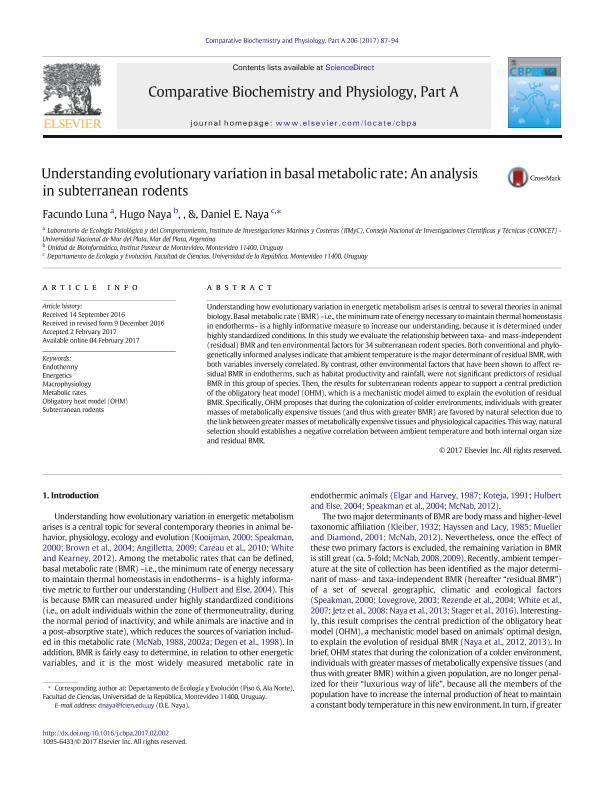Mostrar el registro sencillo del ítem
dc.contributor.author
Luna, Facundo

dc.contributor.author
Anaya, Hugo Daniel

dc.contributor.author
Naya, Daniel E.

dc.date.available
2018-11-20T13:57:06Z
dc.date.issued
2017-04
dc.identifier.citation
Luna, Facundo; Anaya, Hugo Daniel; Naya, Daniel E.; Understanding evolutionary variation in basal metabolic rate: An analysis in subterranean rodents; Elsevier Science Inc; Comparative Biochemistry and Physiology Part A: Molecular and Integrative Physiology; 206; 4-2017; 87-94
dc.identifier.issn
1095-6433
dc.identifier.uri
http://hdl.handle.net/11336/64711
dc.description.abstract
Understanding how evolutionary variation in energetic metabolism arises is central to several theories in animal biology. Basal metabolic rate (BMR) –i.e., the minimum rate of energy necessary to maintain thermal homeostasis in endotherms– is a highly informative measure to increase our understanding, because it is determined under highly standardized conditions. In this study we evaluate the relationship between taxa- and mass-independent (residual) BMR and ten environmental factors for 34 subterranean rodent species. Both conventional and phylogenetically informed analyses indicate that ambient temperature is the major determinant of residual BMR, with both variables inversely correlated. By contrast, other environmental factors that have been shown to affect residual BMR in endotherms, such as habitat productivity and rainfall, were not significant predictors of residual BMR in this group of species. Then, the results for subterranean rodents appear to support a central prediction of the obligatory heat model (OHM), which is a mechanistic model aimed to explain the evolution of residual BMR. Specifically, OHM proposes that during the colonization of colder environments, individuals with greater masses of metabolically expensive tissues (and thus with greater BMR) are favored by natural selection due to the link between greater masses of metabolically expensive tissues and physiological capacities. This way, natural selection should establishes a negative correlation between ambient temperature and both internal organ size and residual BMR.
dc.format
application/pdf
dc.language.iso
eng
dc.publisher
Elsevier Science Inc

dc.rights
info:eu-repo/semantics/openAccess
dc.rights.uri
https://creativecommons.org/licenses/by-nc-sa/2.5/ar/
dc.subject
Endothermy
dc.subject
Energetics
dc.subject
Macrophysiology
dc.subject
Metabolic Rates
dc.subject
Obligatory Heat Model (Ohm)
dc.subject
Subterranean Rodents
dc.subject.classification
Otras Ciencias Biológicas

dc.subject.classification
Ciencias Biológicas

dc.subject.classification
CIENCIAS NATURALES Y EXACTAS

dc.title
Understanding evolutionary variation in basal metabolic rate: An analysis in subterranean rodents
dc.type
info:eu-repo/semantics/article
dc.type
info:ar-repo/semantics/artículo
dc.type
info:eu-repo/semantics/publishedVersion
dc.date.updated
2018-10-23T14:08:25Z
dc.identifier.eissn
1531-4332
dc.journal.volume
206
dc.journal.pagination
87-94
dc.journal.pais
Estados Unidos

dc.journal.ciudad
Nueva York
dc.description.fil
Fil: Luna, Facundo. Consejo Nacional de Investigaciones Científicas y Técnicas. Centro Científico Tecnológico Conicet - Mar del Plata. Instituto de Investigaciones Marinas y Costeras. Universidad Nacional de Mar del Plata. Facultad de Ciencias Exactas y Naturales. Instituto de Investigaciones Marinas y Costeras; Argentina
dc.description.fil
Fil: Anaya, Hugo Daniel. Institut Pasteur de Montevideo; Uruguay
dc.description.fil
Fil: Naya, Daniel E.. Universidad de la República; Uruguay
dc.journal.title
Comparative Biochemistry and Physiology Part A: Molecular and Integrative Physiology

dc.relation.alternativeid
info:eu-repo/semantics/altIdentifier/url/https://www.sciencedirect.com/science/article/pii/S1095643317300363
dc.relation.alternativeid
info:eu-repo/semantics/altIdentifier/doi/https://doi.org/10.1016/j.cbpa.2017.02.002
Archivos asociados
